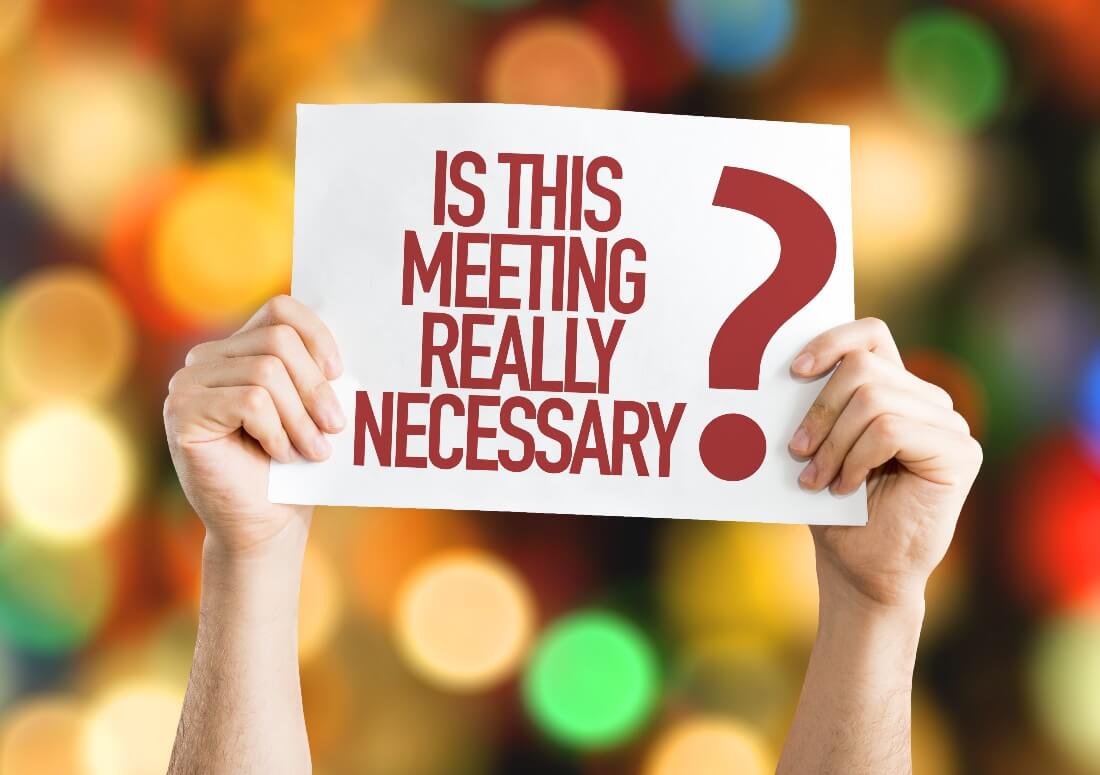When we prioritise, we prevent work from expanding unnecessarily and allocate time wisely. Improving the quality of meetings involves not just instilling better governance around the process of interactions, but judging whether or not they are qualitatively good enough to produce measurable outcomes. Meetings use people’s time so they can be costly distractions if that time is not spent efficiently and effectively.
Exacerbated by the pivot to remote working during lockdown, meetings creep is expanding work with no clear plan or priority. The meeting invitations keep coming, crowding out productive time. Being ‘busy in meetings’ is a problem when we can’t account for what we are doing. Professionals now average 25 meetings a week, according to a report from Reclaim.ai; an increase of almost 70% since the beginning of 2020.
What we work on matters more than how much time we spend on it
Often our time projections for tasks are inaccurate; we tend to inflate our allocation of hours to get things done. This is because we are used to so many interruptions that tasks take much longer than they should. But remove every single possible disturbance and the amount of time you spend on a task will probably remain the same.
If you value productivity over bureaucracy, you may already be familiar with Parkinson’s Law; the adage that work expands so as to fill the time available for its completion. It may be that any ‘extra’ time is not filled with actual work. It is more often spent on filtering, organising, responding and coping with unchecked interruptions from apps, Zoom, emails and messages, which hinder getting the work done.
Work harder and longer is a bureaucratic ideal to which many organisations have subjected their employees due to a legacy of presenteeism or a desire to observe people at work. But we need to recognise that not being able to account for what we have been ‘busy’ doing at the end of the work day is not a measure of endeavour.
Good habits trump bad meetings
Prioritisation starts with stopping meetings creep by challenging their value and recognising the opportunity cost. If a meeting has a clear purpose then the people you invite must also have a reason to attend. Without a role or accountability for progressing decisions made, however, their time will be misused. But if this steady intrusion of meetings is how your organisation believes it gets work done, it’s hard to say no to meetings that won’t make any difference even when it’s easy to spot them.
Bureaucracy is a by-product of our busyness culture but if we start to value what we work on more than how long we spend on things, we can work smarter and faster on specific tasks. Prioritising things that have a clear business case or purpose helps you to say no to things that don’t.
David Cancel, entrepreneur and CEO of software company Drift, has established a culture where employees are urged to avoid calling meetings 98% of the time. People are urged instead to question if the work can be done without a meeting, push back when invited to one and excuse themselves from meetings that are not useful.
In his 2018 annual letter, Amazon founder Jeff Bezos reiterated his rule that PowerPoint is banned in executive meetings. He replaced it with a “memo that is narratively structured with real sentences, topic sentences, verbs and nouns.” This takes time to prepare and everyone is required to start the meeting in silence and read the memo. The rationale being that not only will people start off on an equal footing, but they will recall and retain information presented as a story more effectively than if it were presented as bullet points.
Daniel Kahneman suggests a not too dissimilar and straightforward procedure for the conduct of meetings in his bestseller ‘Thinking, Fast and Slow’. He proposes that before an issue is discussed, all members of the meeting should be asked to submit a summary of their position. This simple rule helps to do two key things. Firstly, it extracts proper value from the diversity of knowledge in the group. And secondly, it counters the negative aspect of open discussion which gives “too much weight to the opinions of those who speak early and assertively, causing others to line up behind them”.
One of the main reasons meetings are neither effective nor efficient is that they simply include way too many people. In ‘How Google Works’ Eric Schmidt and Jonathan Rosenberg tell us not to involve more than 8 people in a meeting. And they urge executives to attend only if they are needed, not if they are looking to feel important.
What is good meetings discipline?

Ultimately it is a combination of the efficiency of proceedings and the effectiveness of collaboration that makes meetings count. Efficiency is about starting on time, staying on track, including as few people as possible and achieving the stated objective. Effective meetings involve the right people for the right reasons and deliver value for the business in terms of a tangible result or actionable decision.
Observing a few principles can help stress test whether meetings are likely to be both efficient and effective:
- Remove recurring meetings (except things like quarterly financial results etc)
- Have an agenda with clear objectives and shareable results
- Make sure the Chair can run the meeting effectively
- Don’t allow the loudest people to monopolise the discussion - request all participants share their position on a matter in advance, where appropriate
- Limit the number of participants and ensure they have a clear role
- Preparation is key - circulate materials that correspond to the agenda in advance
- Start on time - consider denying entry to latecomers
- Be fully present and pay attention - avoid checking devices
- End early when you don’t need the full allocated time - don’t just keep talking
- Consider whether you could remove a meeting that’s worth less than the one you’re about to schedule or accept







